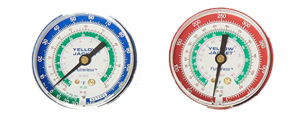
Summary of Knowledge Required for the High-Pressure Examination
Detecting Leaks:
- Know the signs of high-pressure system leaks including traces of oil from hermetic systems and excessive superheat calculations.
- Know that before charging or recharging equipment you need to test for leaks.
Know the preferred order for using leak testing gases; That nitrogen alone is best, then using nitrogen with trace quantity of R-22 is next and better than using pure refrigerant.
Repair Requirements for Leaks:
- Knowledge of the allowable leak rate for commercial and industrial process refrigeration.
- Knowledge of the allowable leak rate for appliances containing more than 50 pounds of refrigerant.
- Know the importance of record-keeping regarding leak repairs of equipment.
- Knowledge of timeline extensions for repairing leaks that exceed the threshold leak rate.
Techniques of Recovery:
- Know that recovering liquid refrigerant at the beginning of the recovery process speeds it up.
- Knowledge of other methods for speeding the recovery operation like chilling the recovery vessel or heating the appliance from which refrigerants are being recovered.
- Know about the ways to reduce cross-contamination and/or emissions when recovery/recycling equipment is used with new refrigerants.
- Knowledge that you need to wait a few minutes after reaching a required recovery vacuum in order to see if the system pressure rises which would indicate liquid refrigerant is still in the system or in the oil.
Requirements for Recovery:
- Know the refrigerant evacuation requirements for high-pressure appliances when those appliances will be disposed.
- Know the refrigerant evacuation requirements for high-pressure appliances for major repairs and non-major repairs.
- Know the refrigerant evacuation requirements for leaky versus non-leaky appliances.
- Know evacuation requirements for high-pressure appliances using recovery/recycling equipment built before and after November 15 1993.
- Know the definition of a “major” repair.
- Know that you are prohibited from using system-dependent recovery equipment on systems that contain more than 15 pounds of refrigerant.
Know the refrigerant evacuation requirements of appliances containing more or less than 200 pounds of refrigerant.
Refrigeration:
- Know how to identify the refrigerants within appliances.
- Know the pressure-temperature relationships of common high-pressure refrigerants using temperature-pressure chart.
- Know how to convert gauge pressure (psig) to absolute pressure (psia) and vice-versa.
- Knowledge of the components of high-pressure appliances like the receiver, evaporator, accumulator, etc, and the state (vapor/liquid) of refrigerant within those components.
- Know the idea that hydrocarbons are not approved for retrofits.
Safety:
- Know that hermetic compressors should not be run under a vacuum.
- Know that equipment room requirements mandated by ASHRAE Standard 15 require an oxygen deprivation sensor with all refrigerants.
Type 2 High-Pressure Practice Tests
Type 2 Test 1
Type 2 Test 2
Type 2 Test 3
Type 2 Test 4
608 Navigation
BACK to Certification Types
BACK to EPA 608 General Info
BACK to HVAC Tech Page
